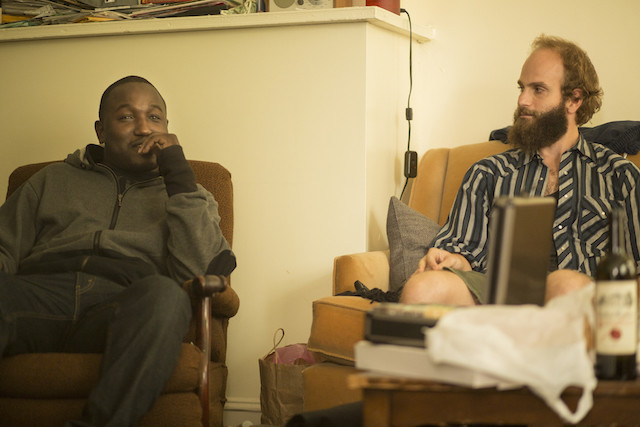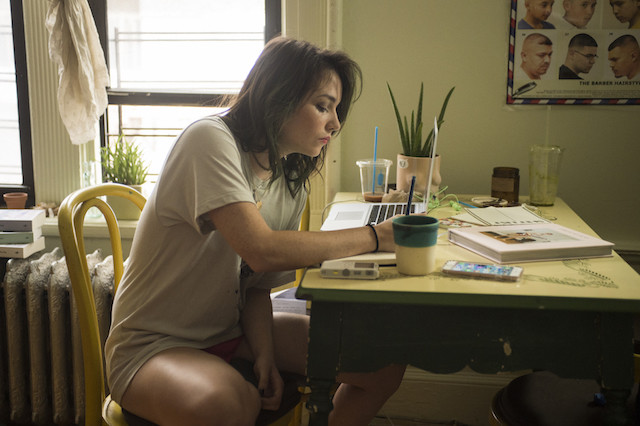
We live in a world where we’re constantly bombarded by media. Our interactions with the world are filtered through our phones, to the point that even television shows conceive of “second screen experiences” for us to look at and interact with when not watching the actual program. Most of us get our news through aggregators of news, repackaging content in smaller, easily digestible, easily forgettable pieces. When a friend tells us they’re “taking a break” from social media and deleting their accounts, it’s pretty commonplace, if maybe seen as a bit extreme. Is there any other technology in our lives that could feel so oppressive, we actually have to physically remove its presence? And yet media is so ubiquitous that we can’t actually escape it, so the result is a strange and tense relationship with media, as this week’s episode, “Selfie” illustrates.
“Selfie” goes heavy on the meta. It’s a creative reflection not just on the characters, but on the series itself. Given how politically fraught this year is, maybe there hasn’t been enough time for High Maintenance to go through the typical cycle of critical acclaim and then suffer the backlash of a thousand think pieces (we hope this is true, at least), but the show’s creators seem happy to confront their own demons before anyone else has a chance. This is a hard look in the mirror that they’re taking, asking themselves if their concept itself is problematic.
The episode doesn’t let us forget that the show traffics in privileged territory, where tales of a drug dealer operating in New York are allowed to be whimsical because the weed dealer, and many of his clients, are white. Whether critics give the show a pass on this or not, creators Katja Blichfeld and Ben Sinclair don’t seem to want it.
The Homeless Heidi “pilot” hammers home the idea of confronting the show’s own demons in the second half, but the first half has just as much to say, if more subtly. We’re first introduced to Anja (Ismenia Mendes), a NYU student with journalistic aspirations, but also a social media addiction. Anja’s story begins with an assault on our senses, a reflection of what our own living rooms might be like. The first minutes overlap scenes of Anja’s life, her Instagram account (our own second screen experience on the first screen), and voicemails playing in the background. It’s overwhelming, and we don’t need to get to the end to feel really fucking depressed watching this girl’s life.
Anja lives her life exclusively for her selfies on Instagram. She eats and drinks for the pics, and talks about treating herself to new clothes that she’s only trying on. Even a picture of a supposed interaction with another human, her pedicurist, is painfully faked. When The Guy enters the scene for an interview with Anja, her compulsion to post an unethical picture of her weed dealer interferes with her actual passion: journalism. By the time her story ends, and The Guy asks her to take down the picture, we’re left watching her cry until the scene mercifully goes black, presumably because even the camera can no longer bear it.
________

On the surface, this type of story seems a little beneath High Maintenance. It’s a well-worn trope/commentary on social media addicts that they are (SURPRISE!) not as happy as they make themselves appear on their accounts. It’s so prevalent that I actually see articles about the misleading nature of social media on my social media. That’s not to say the series handles Anja poorly, but it’s just a lazy character. We’ve ALL seen this part of New York already. The real value of Anja’s story is that we see the human tendency to edit our lives to show our best self, which is then contrasted against Heidi, who has no choice about how she is portrayed.
Anja, when in control of her narrative, chooses to show a hyper-glamorized, aspirational version of it. This is how she wants to be seen, whether it’s true or not. But things get more interesting (from the meta angle) when she interviews The Guy. On his way to Anja’s apartment, he passes by cops arresting black men on the sidewalk while civilians are on the scene, recording on their phones—another instance of media being used (in a positive way). This scene gets called back when Anja is interviewing The Guy, talking about the racial politics of a white weed dealer operating with no problems while a significant amount of black people are incarcerated every day for drug related crimes. The Guy’s response is, “I thought I was going to talk about fun drug stories, not talk racial politics,” which serves as a direct commentary on the series itself. The show is aware of its privilege, and it’s letting us know there are many more stories in the city it won’t be able to tell.
________

The second story is more overtly a reflection/selfie of the series. We revisit Heidi (Greta Lee), who appeared in the second episode of the webseries, “Heidi.” Heidi watches a TV and learns about a new sitcom Homeless Helga that plays out exactly like her web episode did: boy meets girl, they spend every minute at his apartment until she’s exposed by The Guy as a homeless grifter who meets guys online and moves in.
It’s great seeing Heidi again, and she is fucking hilarious as she smirks and screams her way through “Selfie.” I could literally watch an entire episode of her just giving reaction shots during arbitration meetings. In this very Sex and the City stylized Homeless Heidi episode, we see High Maintenance purposefully give itself the “HBO treatment.” There’s upbeat SATC music, cute wipes between scenes, and a plot that is tonally different from anything the series has done in past episodes. Compared with the previous episodes’ stories, this one has the very sitcom-y plot of Heidi seeing her life turned into a successful television comedy, complete with Brett Gelman playing “Guy” to mirror “The Guy.”
It’s a bit of a joke on what High Maintenance could have become when it made the jump from webseries to TV, if it were turned into another cute comedy about young Brooklynites, exaggerating life for humor. Brett Gelman’s sound byte that “Brooklyn is a character in itself” is a joke that stings hard for anyone trying to pontificate about (or, errrr, recap) the show. The episode is stuffed with shout-outs to SATC, Girls and Broad City, which have all had the same said about them. These are all winks to the camera, sure (including when Heidi uses Hannibal Buress to contact The Guy for a deposition and he talks about how it’s hard for him to do a guest spot on shows), but at the heart of this story is the idea that someone has profited off telling their skewed version of someone else’s story. In fact, the character of Heidi herself is probably based on someone else’s life.
Heidi and The Guy feel like their lives were appropriated for a television show, and without their permission. The Guy felt violated when Anja took his picture for her Instagram after he expressed that he wanted to remain anonymous. This episode shows us the violence that media performs on people when it feeds on their lives. It needs subjects, but then it doesn’t necessarily want or is even interested in the whole picture. Heidi isn’t a person; she’s a punchline. When The Guy tries to get past a PA on set at the shooting of a Girls episode, we see how we are forced to play by the media’s rules. They want us in the shot when it makes sense, not when it’s reality. It almost feels like High Maintenance is telling us, “Hey, don’t fall for the trap that we’re dealing in realism. These may feel real, but they’re still just stories.”
More importantly, there is always more to the story that we’re not seeing. It’s like that final scene where Heidi is sitting in the coffee shop. She’s engaged to be married to a wealthy, loving man. She seems to have finally hit it big, as far as her “live-in girlfriend” con (as the show might describe it, I don’t want to judge her sexuality) goes. Yet we see her spot something off camera, and then she transforms into a blind person, “bumping” into an elderly lady. During the credits, we see the elderly woman is now leading her down the street, and I for one was completely clueless about the con here. But I think that’s supposed to be the point. Heidi, like all of the series’ subjects, is a person, and we might think we know her and the others from the stories we’ve seen, but there’s even more that we haven’t seen. That’s a pretty big blind spot.
Catch up on the rest of the season here.
For more massive rips off the Eric Silver bong, follow him on Twitter: @primesilver.
Leave a Reply



